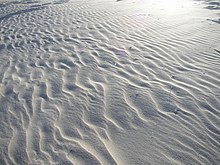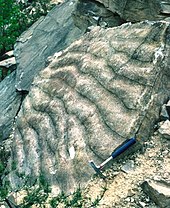Ripples


Ripples also ripple marks , wave form , bottom form , transport body , dune and subaquatic dune are wave-like surface shapes caused by a flowing medium (on earth air and water) at the interface of this medium to a sandy sediment . Ripples and the oblique stratification they create are among the sedimentary structures . In the case of ripples, a distinction is made between two forms, depending on their origin: flow ripples and oscillation ripples. In addition, a number of different nomenclatures are used in the specialist literature. Neither in the German nor in the English-speaking world was able to establish a certain nomenclature, although that of Ashley (1990) is probably one of the most widely used.
Flow ripple
A first minimal increase creates an obstacle in the surface of the sand bottom, on which grains of sand carried along by the current can accumulate. The larger the obstacle, the more grains accumulate ( positive feedback ). The result is asymmetrical flow ripples with a flat windward and a steep leeward side .
Aquatic flow ripples occur in sand when the flow velocity is just above the critical velocity. Flow ripples are asymmetrical, with a smaller slope on the windward side facing the flow and a steeper slope on the lee side facing away from the flow. The average height of ripples is 3–5 cm and their wavelength is 4–60 cm. In order for ripples to occur, a minimum water depth of around 3 times the ripple height is required. Since the ripple formation is determined by the processes in the boundary layer, the maximum depth for the ripple formation is not limited upwards. The maximum sand grain diameter for the formation of ripples is 0.6–0.7 mm. With larger grain diameters, large ripples and giant ripples occur. Ripples and large ripples are not stationary, but migrate in the direction of the flow.
When the critical flow velocity for the movement of sand grains is reached, the grains begin to move and clump together in small clusters . As a result, irregularities form on the sediment surface, which are few grain layers thick and which influence the flow in the boundary layer. Above the irregularities that form small mounds, the streamlines are closer together and the flow speed increases. Granules of sediment can thereby be transported rolling or jumping up the windward side of the small hill and accumulate at its upper end. If too many grains are piled up, the situation becomes unstable and the grains slide down the leeward slope and are deposited there. These thin layers are grain (engl. Leeblätter as foresets ) referred to and form the natural slope angle of about 30-35 ° from. By repeating this process, layer upon layer is formed, separated and laminated by intermediate layers of finer sediment that precipitates out of the suspension. A ripple gradually develops. The current divides at the crest of the ripple. Part of the current continues to flow over the sediment surface. The other part forms irregular eddies on the leeward side or hits the sediment surface, where increased turbulence and erosion form the troughs between the ripples. Some of the eroded grains can be transported by the backflow vortex to the foot of the leeward slope and deposited there as a thin layer. The other part is either absorbed into the fluid or transported back over the windward slope of the ripples. If some of the grains are deposited on the windward side, the so-called windward leaf is formed there.
Oscillation ripple
These structures, also known as wave or tidal ripples, arise when the current oscillates over the sand , i.e. that is, comes alternately from different, ideally opposite directions. The ideal case is e.g. B. given on a flat beach on which the water runs back in the opposite direction in the direction from which the incoming wave came in. But every surface wave also creates back and forth movement on the floor. The result of these pendulum movements are ripple marks with a symmetrical cross-section.
According to their size, ripples are divided into three groups:
- Ripples, usually between 3 and 5 cm high and with a wavelength of 4–60 cm
- Large ripples, between 6 cm and 1.5 m high and with a wavelength between 0.6 and 30 m
- Giant or mega-ripples, between 1.0 and 8.0 m high, with a wavelength greater than 30 m
Large and giant ripples occur with grain sizes of more than 0.6–0.7 mm. Only the giant ripples are stationary, the other ripples move with the current.
In contrast to stress marks, ripple marks are structures on the top of a sediment layer. Both can thus serve to determine the original storage of the sediment ( geopetal structure ).
See also
Similar surface structures can also form under completely different conditions. Waves of a similar height and (rather shorter) wavelength are formed by the interaction of tires and chassis of vehicles with the loose material of the pavement of unpaved roads , which are then referred to as washboard or corrugated iron runway .
Individual evidence
- ^ H. Murawski, W. Meyer: Geological dictionary. 11th edition. Spectrum Academic Publishing House, 2004, ISBN 3-8274-1445-8 .
- ^ GM Ashley: Classification of large-scale subaqueous bedforms; a new look at an old problem. In: Journal of Sedimentary Petrology. 60 (1), 1990, pp. 160-172.
Web links
- 'sand ripples' PDF document (1.63 MB)



